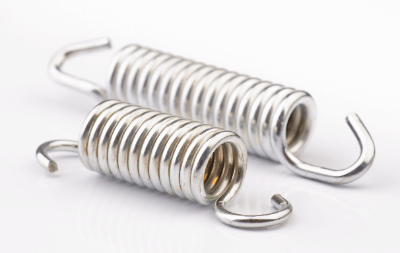What Is Spring Steel?

Spring steel is a steel material used to make various types of springs.
It is available in wire, bar, and strip forms. The method of manufacturing springs can be classified into “hot forming,” in which the material is formed into a spring shape and then heat treated, and “cold forming,” in which the material is formed into a spring shape at room temperature using heat treated material.
JIS G4801 standardizes “spring steels”. In this standard, only materials for hot-formed springs (materials that have not been heat-treated) are specified, but materials for cold-formed springs (materials that have been heat-treated) are also generally called spring steels.
Uses of Spring Steel
Spring steel is used to make various types of springs. It is used to make tension coil springs, compression coil springs, threaded recoil springs, torsion bars, laminated plate springs, plate springs, etc.
1. Hot Forming Spring Steel
Hot-formed spring steel is specified by JIS as a standard size from Φ9 in the case of wire rods and is used for large springs such as automobile suspensions.
2. Spring Steel for Cold Forming
Cold-formed spring steels are available in small diameters and thin sheets and are widely used for spring products used in precision equipment, industrial machinery, toys, and general household products.
Types of Spring Steel
1. Spring Steel for Hot Forming
High-strength materials are used for spring steels. Nine types of materials for hot-formed springs are specified in JISG4801:2021, “Spring Steel Products (SUP)”. The strength of these materials is not adjusted before they are formed into spring shapes. The materials are heated at 900°C to 1,200°C until they turn bright red, cut to the required length, coiled, and formed.
Quenching and tempering are then performed to obtain spring properties. Although hot-formed springs are large, they can be processed with little force through this process. However, strict temperature control is required.
2. Spring Steel for Cold Forming
Examples of spring steels for cold forming are hard steel wire (SW), piano wire (SWP), and stainless steel (SUS). These materials for cold-formed springs are already heat-treated as raw materials and have spring properties.
Spring forming is done at room temperature, followed by annealing. Compared to hot forming, the force required during the forming process is larger, so it is suitable for processing small springs. Cold-formed springs can be processed stably, and most of the springs that we usually see are cold-formed springs.
Structure of Spring Steel
Stainless steel, alloy steel, and high carbon steel are used as spring steel materials. Spring steel is divided into two types of shapes: long and thin wire rods and flat plates.
1. Wire Rod
The wire rod or bar is long and thin. Typical examples of wire rods of spring steel for cold forming are hard steel wire and piano wire. Both are manufactured by drawing them through the holes of a die while reducing their diameter. Unlike wire-like wire, the composition of hard steel wire contains a large amount of carbon. Hard steel wire can be used for everyday items such as beds and chairs.
2. Plate
The plates are flat. Spring steel used for thin plate springs is called steel strip. Like piano wire, it can be manufactured by rolling process. Some types are used directly for spring forming after cold rolling, types that are annealed after rolling, and types that are quenched and tempered after rolling.
How to Select Spring Steel
The use of spring steel depends on the type of steel material. For example, manganese chromium steel and silicon manganese steel can be used for coil springs, plate springs, and torsion bars. Chromium vanadium steel is mainly used for coil springs and torsion bars, and silicon chromium steel is mainly used for coil springs.
Chrome molybdenum steel is used for large coil springs and plate springs, and manganese chromium boron steel is used for large coil springs, plate springs, and torsion bars.